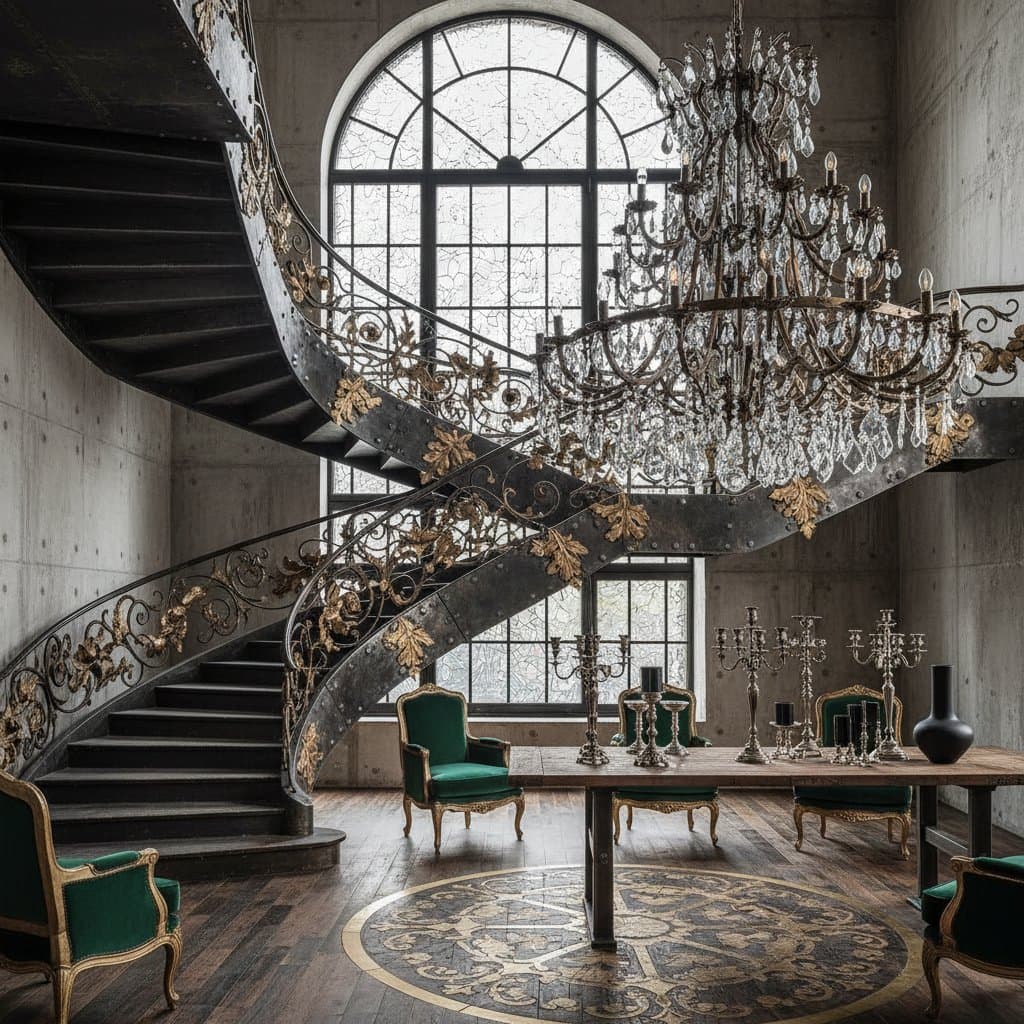Industrial Baroque: Blending Grit and Ornate Elegance
Industrial design offers clean lines, yet it sometimes lacks warmth and personality. Baroque elements provide elegance through intricate details, but they can appear too delicate for contemporary spaces. Industrial Baroque merges these aesthetics, combining raw materials with sculptural ornamentation inspired by classic European styles.
This approach requires confidence in execution. When balanced properly, it transforms ordinary rooms into compelling statements. The focus remains on harmonizing texture, finish, and form to create intentional, cohesive environments.
Defining Industrial Baroque
Industrial Baroque unites contrasting aesthetics. Industrial elements include exposed brick, metal beams, and aged finishes that evoke strength and authenticity. Baroque influences introduce intricate carvings, curved forms, and luxurious details that add refinement and drama.
The essence emerges from deliberate contrast. Heavy iron pairs with ornate gold leaf accents. Matte black fixtures complement carved wood panels. This fusion results in layered spaces that feel grounded yet sophisticated, bold yet habitable.
Incorporating Industrial Baroque into Your Home
Achieve this style without a complete overhaul. Success depends on strategic layering. Follow these steps to plan and implement an Industrial Baroque design effectively.
Establish a Raw Foundation
Begin with industrial elements to anchor the space. Emphasize structural materials to build texture and depth.
- Walls: Opt for exposed brick or rough plaster to introduce immediate character. For smooth surfaces, apply limewash paint or textured finishes mimicking concrete.
- Floors: Select polished concrete, weathered wood planks, or dark slate tiles. Maintain matte surfaces to preserve the unrefined appeal.
- Ceilings: Incorporate exposed wooden beams or ductwork for visual weight. In absence of natural features, install perforated metal panels to simulate industrial architecture.
Integrate Baroque Elements Thoughtfully
Layer in ornate details after securing the base. Exercise restraint to ensure details enhance rather than dominate.
- Lighting: Select chandeliers with flowing curves crafted from aged brass or forged iron. These pieces introduce elegance without overpowering the raw backdrop.
- Furniture: Choose items with carved legs or embossed trim finished in distressed patinas. Reupholster a traditional armchair in durable leather or linen to unify the styles.
- Mirrors and Frames: Employ gilded or antiqued frames against neutral walls. Position them to reflect light and add historical depth to modern settings.
Combine Metals and Textures for Contrast
This style flourishes through material interplay. Encourage mixing to heighten visual interest.
- Iron and Brass Pairings: Use iron for sturdy frameworks, complemented by brass or bronze for subtle warmth.
- Finish Variations: Alternate polished elements with those showing patina. A gleaming brass handle, for instance, contrasts effectively with rusted steel panels.
- Wood-Metal Hybrids: Pair salvaged wood tabletops with intricately forged metal bases on dining tables or consoles.
Select a Harmonious Color Scheme
A subdued palette underscores textures and shapes in Industrial Baroque.
- Neutral Bases: Employ charcoal grays, soft ivories, and earthy taupes as foundational tones.
- Accent Hues: Introduce deep jewel colors such as emerald green or rich burgundy in limited applications, like upholstery or artwork.
- Metallic Tones: Incorporate darkened steel and aged brass to provide contrast and dimension without excess shine.
Implement Layered Lighting Strategies
Lighting defines the atmosphere in these interiors. Use multiple sources to create depth and highlight features.
- Ambient Sources: Install wall-mounted sconces or overhead fixtures exposing mechanical components.
- Task and Accent Lights: Deploy adjustable spotlights or linear tracks to illuminate carvings or rough surfaces selectively.
- Statement Pieces: Feature a dramatic chandelier or multi-arm candelabra to infuse the space with theatrical flair.
Key Considerations for Implementation
Understand the practical aspects before committing to Industrial Baroque.
Budget Expectations
Costs depend on the scope of changes.
- Modest Investments (2,000 to 5,000 dollars): Focus on surface-level updates, including paint applications, hardware replacements, and decorative accessories.
- Moderate Projects (8,000 to 20,000 dollars): Include flooring installations, comprehensive lighting overhauls, and integrated metal elements.
- Premium Transformations (25,000 dollars and above): Encompass complete redesigns with bespoke woodworking, custom metalwork, and specialized finishes.
Custom metal fabrication often ranges from 100 to 300 dollars per square foot, influenced by design intricacy.
Project Timeline and Complexity
Simple cosmetic adjustments require only weekends of effort. Extensive renovations span several months. This style presents moderate to high complexity, particularly with metal integration. Handle surface treatments independently, but engage experts for structural modifications, electrical work, and fabrication.
Safety and Structural Guidelines
Verify non-load-bearing status before exposing walls or beams. Use protective equipment like gloves and goggles during metal or concrete handling. Ensure all electrical installations comply with local codes through licensed professionals.
Investment Value
Industrial Baroque appeals in urban and artistic locales, offering solid resale potential. Properties with superior craftsmanship recover 70 to 80 percent of renovation expenses. Prioritize resilient materials and quality fixtures for enduring appeal.
Adapting to Regional Contexts
Tailor the style to local architecture and environment.
- City Lofts: Leverage inherent brick and beams, softened by velvet fabrics or sculpted wood elements.
- Suburban Residences: Apply lighter tones and sparse ornamentation to promote openness.
- Heritage Buildings: Enhance existing moldings or arches with matte black metal accents for heightened contrast.
In humid or coastal areas, select rust-resistant powder-coated metals or sealed surfaces to safeguard durability.
Executing Your Industrial Baroque Vision
Embrace imperfection as part of the appeal in Industrial Baroque. It highlights the interplay of raw edges and refined artistry. Initiate with minor swaps, such as installing a forged metal mirror or upgrading to a curved fixture. Progress to ambitious endeavors like room-wide overhauls or tailored installations as confidence builds. Prioritize skilled execution to allow materials to convey their narrative authentically.
